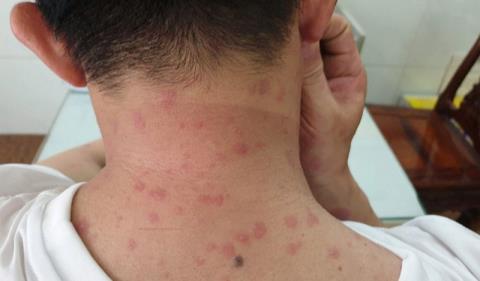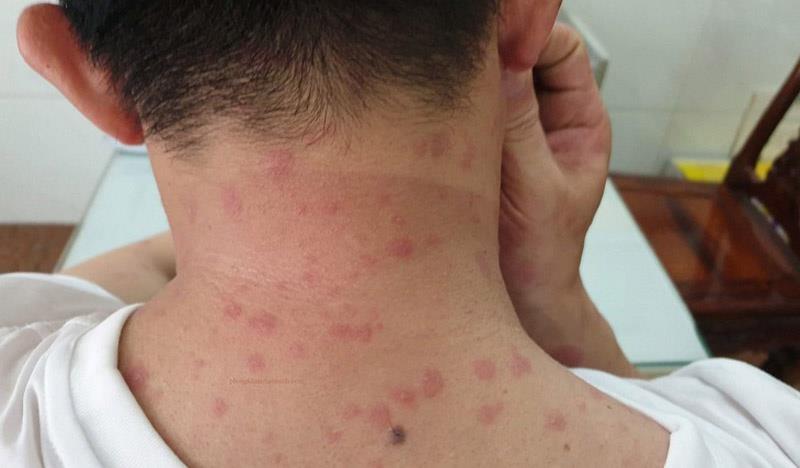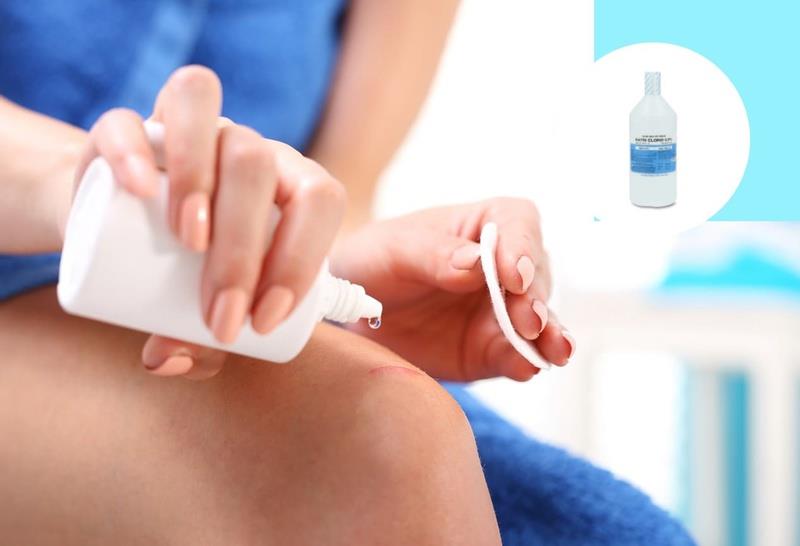Instructions for first aid when bitten by a centipede

As a country with a hot and humid climate, centipedes are a common insect in our country, common in both rural and urban areas. Accidents caused by centipedes also happen quite often. So when unfortunately being bitten by a centipede, how to handle it, SignsSymptomsList would like to give some information for readers to understand and know how to give first aid when bitten by a centipede.
With the characteristics of the habitat being humid places, we can also encounter centipedes everywhere. It is a poisonous insect that, when bitten, can poison our body and even lead to death. Therefore, first aid skills for centipedes are essential skills for everyone.
Manifestations of being bitten by a centipede
Centipedes belong to the group of arthropods with venom to hunt, centipedes eat small invertebrates, can also attack and kill small mammals with venom such as bats, frogs, etc.
We can easily identify centipedes by its external appearance: the body is divided into many segments, elongated, often divided into 15-20 segments, each segment corresponds to a pair of legs, in front of its mouth there is a pair. Pliers (also called canines) contain toxins.
At present, when the weather turns to summer with many days of heavy rain, favorable conditions for the development of arthropods such as centipedes. Therefore, accidents caused by centipedes are more common in the summer.
Given the climatic and natural conditions in our country, centipedes are common creatures
When bitten by a centipede, poisons in pairs of pliers enter the human body, causing local lesions as follows:
- Common locations in the legs and arms.
- The bite is painful, swollen, hot, red, and bleeding.
- Itching and burning like a burn.
- More severe can infect the bite, even gangrene.
- Swollen peripheral lymph nodes near the bite site.
Is it dangerous to be bitten by a centipede?
Their venom contains more than 50 types of biologically active proteins, acting as degrading enzymes that are toxic to many cells and organs in the body such as muscle cells, heart muscle, nerve cells. Not only causing local swelling, the poison can travel through the bloodstream to the whole body, causing extremely dangerous complications. With larger centipedes, the greater the amount of venom, the more dangerous it is.
First of all, a person bitten by a centipede can go into anaphylaxis, which is an acute, potentially life-threatening allergic reaction within minutes of being exposed to the centipede venom. The mechanism is due to the immune system over-releasing chemical mediators after the presence of foreign substances into the body. There are 3 levels of anaphylaxis including:
- Grade 1 only causes skin symptoms such as itching, rash, urticaria in the whole body.
- Grade 2 in addition to skin manifestations also causes shortness of breath, chest tightness, abdominal pain, nausea, vomiting, diarrhea, etc.
- Level 3 is very dangerous, in addition to the above symptoms, it also causes low blood pressure, small and fast pulse that is difficult to catch, disturbances of consciousness from confusion and loss of consciousness, falling into a coma, respiratory arrest, cardiac arrest, and death.
Not only that, people who are bitten by a centipede can also suffer from multi-organ failure because the centipede toxin is toxic to many organs at the same time:
- Liver failure, kidney failure, etc.
- Myocarditis causes cardiac arrhythmias , at worst causes cardiac arrest and death.
- Acute rhabdomyolysis causes acute renal failure.
- Coagulopathy manifests as subcutaneous bleeding, gastrointestinal bleeding, or persistent bleeding from a centipede bite.
- Systemic infection, septic shock.
 Manifestations of being bitten by a centipede
Manifestations of being bitten by a centipede
Instructions for first aid when being bitten by a centipede quickly
Let's immediately take basic first aid steps to reduce the risk of dangerous complications outlined above.
- Immediately wash the wound with soap and clean water.
- Do not apply anything to the wound such as chicken drool (a folk remedy) that only aggravates the infection of the bite.
- If possible, disinfect with medical alcohol to reduce the risk of infection of the bite.
- Apply heat to relieve pain at the wound site.
- After that, the person bitten by the centipede should go to a medical facility such as a health station to conduct SAT injections to prevent tetanus, pain relief, prophylactic antibiotics and take care of the bite hygiene.
Follow up after being bitten by a centipede
Centipede bites rarely leave dangerous symptoms, usually symptoms usually go away after a few hours or days. However, it is necessary to closely monitor in the first hours to detect possible systemic complications in a timely manner. Close monitoring is required in subjects with chronic diseases such as diabetes, reduced resistance, immunodeficiency, etc., and also those with atopy. Follow up after a centipede bite the following signs:
 Instructions for first aid when bitten by a centipede and monitoring after first aid
Instructions for first aid when bitten by a centipede and monitoring after first aid
Signs of an allergy
Signs of an allergic reaction after an insect bite are the same as in other cases. Including itching, generalized urticaria, eyelid edema, difficulty breathing, wheezing, etc. When these symptoms are present, even at level 1 anaphylaxis, it is necessary to go to a medical facility to use antiretroviral drugs. guard. In addition, going to a medical facility will also allow patients to be treated promptly when any acute developments occur.
Vital signs
- Respiratory status: Number of breaths per minute, shortness of breath, etc.
- Circulatory: Capture large vessels such as inguinal vessels, carotid vessels, etc.
- Consciousness, if there is a slow response, lethargy, or coma, there is a disorder of consciousness.
The above systemic symptoms warn that the body is being severely damaged, damage many organs, possibly death.
Spot sign
The bite is swollen and wide around, the mouth is dead, the pus discharge is a lot, ... is a prediction of an infection of the bite, if not treated early, the infection spreads throughout the body.
When there are signs of allergy, the whole body, as above, the person bitten by a snake should go to the nearest hospital for timely detection and diagnosis of complications.
With a hot and humid tropical climate, to avoid centipedes in our living environment, we should take measures to prevent and kill centipedes for our home:
- Always keep the house clean, cool, avoid moisture.
- Use protective gear such as gloves, long clothes, and boots when working in areas with many centipedes.
- Clear shrubbery around the house.
- Should remove waste, unused food out of the house as quickly as possible to limit where centipedes live and food sources.
- Spraying insecticides, killing mosquitoes is also a very effective method to limit centipedes as well as other arthropods.
Being bitten by a centipede may seem like a harmless accident, but it also has the potential for unforeseen events. Therefore, first aid when bitten by a centipede and follow-up after first aid is very necessary. SignsSymptomsList hopes to have brought useful knowledge to you.